Elamite clay tablet discovered in southwest Iran

TEHRAN – A clay tablet, estimated to date from the Elamite era (c. 2700 – 539 BC), has recently been discovered in southwest Iran.
The tablet which bears cuneiform inscriptions was found during a cultivation process on a personal farm in Ramhormoz county [of Khuzestan province], a senior police official in charge of protecting cultural heritage said on Monday.
“According to examinations conducted by experts of the Ministry of Cultural Heritage, Tourism and Handicrafts, the object has been assessed to date from the Elamite era,” the police commander said, CHTN reported.
The official, however, did not provide further detail about the prehistorical piece of document.
Last November, French archaeologist Francois Desset publicized that he had deciphered a 4400-year-old cuneiform bas-relief in a study, which he said might be a “cultural revolution” in the history of writing in the world scene. This writing system was practiced for more than a century, at the end of the third millennium and the beginning of the second millennium BC, on the vast plateau of Iran and Elam territory.
The study suggests ‘Mesopotamia’ (present-day Iraq / former Babylon) is no longer the world's first cradle of writing, the news agency reported. It took the French archaeologist and Iranian fellows some ten years to [completely] discover the mysteries of the cuneiform inscription, which is hand-carved on clay tablets and were found in the ruins of the ancient city of Susa, southwest Iran.
Elamite language, extinct language spoken by the Elamites in the ancient country of Elam, which included the region from the Mesopotamian plain to the Iranian Plateau. According to Britannica, Elamite documents from three historical periods have been found. The earliest Elamite writings are in a figurative or pictographic script and date from the middle of the 3rd millennium BC.
Situated in a region inside the modern-day provinces of Ilam and Khuzestan, Elam was one of the most impressive civilizations of the ancient world. It was never a cohesive ethnic kingdom or polity but rather a federation of different tribes governed at various times by cities such as Susa, Anshan, and Shimashki until it was united during the Middle Elamite Period, briefly, as an empire.
The name Elam was given to the region by others – the Akkadians and Sumerians of Mesopotamia – and is thought to be their version of what the Elamites called themselves – Haltami (or Haltamti) – meaning “those of the high country”. 'Elam', therefore, is usually translated to mean “highlands” or “high country” as it was comprised of settlements on the Iranian Plateau that stretched from the southern plains to the elevations of the Zagros Mountains.
Susa was once the capital of the Elamite Empire and later an administrative capital of the Achaemenian king Darius I and his successors from 522 BC. Throughout the late prehistoric periods, Elam was closely tied culturally to Mesopotamia. Later, perhaps because of domination by the Akkadian dynasty (c. 2334–c. 2154 BC), Elamites adopted the Sumero-Akkadian cuneiform script.
Documents from the second period, which lasted from the 16th to the 8th century BC, are written in cuneiform; the stage of the language found in these documents is sometimes called Old Elamite. The last period of Elamite texts is that of the reign of the Achaemenian kings of Persia (6th to 4th century BC), who used Elamite, along with Akkadian and Old Persian, in their inscriptions. The language of this period, also written in the cuneiform script, is often called New Elamite.
Although all three stages of Elamite have not been completely deciphered, several grammatical features of the language are known to scholars. These include a plural formation using the suffix -p, the personal pronouns, and the endings of several verb forms.
AFM
Leave a Comment